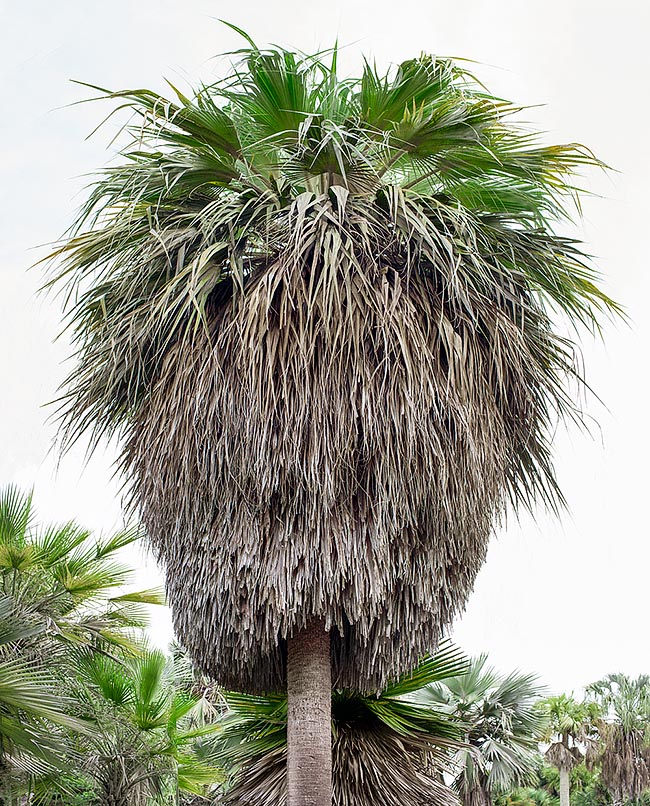Family : Arecaceae

Text © Pietro Puccio

English translation by Mario Beltramini
The species is endemic to Haiti where is present with few specimens on the north-western coast, mainly on rocky semi-arid soils characterized by low xerophilous vegetation, close to the sea.
The genus is honoured to the Polish astronomer Nicolaus Copernicus (1473-1543), the species to the Swedish botanist Erik Leonard Ekman (1883-1931).
Common names: Ekman’s silver palm, straw man (English); homme paille (French); jamm de pay, om de pay (Haiti).
The Copernicia ekmanii Burret (1929) is a solitary monoecious pecies erect, in nature up to about 4-5 m tall, with cylindrical stem, of 15-20 cm of diameter, smooth and greyish hidden under the top by a thick mass of persistent dry leaves. The leaves, on a petiole provided on the margins of robust curved spines and covered by a thick white waxy patina, 0,5-1 m long and 3-5 cm broad, are palmate, almost circular of about 1 m of diameter, of green colour above, glaucous and covered by white waxy patine below, spiny on the margins.

Endemic to Haiti, Copernicia ekmanii is a “red list” species at high risk of extinction. Too much exploited because of the leaves, used for the covering of the rural dwellings, is nowadays rare in nature and even more in cultivation © Giuseppe Mazza
The foliar lamina is incised in about 50 linear-triangular segments with acuminate apex, rather rigid, united at the base per about 1/3 of their length. Inflorescences between the leaves (interfoliar), curved, 0,8-1 m long, with 6 orders of ramifications and glabrous rachillae, up to about 5 cm long, carrying close hermaphroditic flowers, solitary, about 3 mm long, of cream white colour, with tubular trilobed corolla, 3 carpels and 6 stamina with the wide filaments united at the base.
The fruits, developping usually from one only carpel, are ovoidal, about 2 cm long and of 1,6 cm of diameter, with the residues of the carpel at the base and of the stigma at the apex, of glossy black colour when ripe, containing one only globose seed of about 1,2 cm of diameter.
It reproduces by seed, previously kept in water for two-three days, in sandy loam maintained humid at the temperature of 26-28 °C, with a low percentage of germination.
One of the most characteristic and ornamental of the genus, rare in nature and even more in cultivation, of slow growth, cultivable as isolated specimen or in group in the gardens of the tropical and subtropical regions, when adult it can stand occasional and very short lasting decreases of temperature up to about -1 °C.
It requires full sun or at most a slight shade during the first stages of the growth and draining soils, slightly acidic to slightly draining, even poor, well rooted can resist to long periods of drought, but grows more quickly if regularly irrigated in the seasonal climates characterized by long warm and dry summers; useful are the fertilizations with balanced products with slow release microelements. It stands well the strong winds and the marine aerosols, hence can be employed in gardens close to the sea.
The dry leaves, particularly resistant and lasting, have been widely utilized in the past as cover of rural dwellings and for realizing various common use objects; the stems in the constructions.
Due to the limited number of individuals, present in a limited area, the poor regeneration and the above mentioned wide use that has been done, and that continues even if in more limited measure, the species has been inserted in the red list of the IUCN (International Union for the Conservation of Nature and Natural Resources) as “Endangered” (at very high risk of extinction in nature in the forthcoming future).
